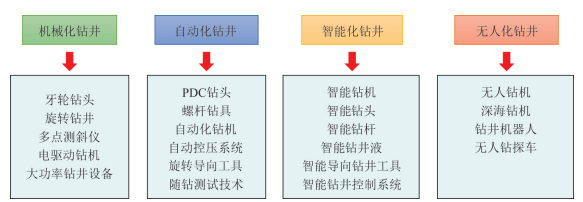Click the blue text
Follow us
Shanghai Society of Civil Engineering

Image source: Geotechnical Bureau
01
Basic Theory of Intelligent Drilling
Intelligent drilling integrates theories and technologies such as big data, artificial intelligence, the Internet of Things, cloud computing, virtual and augmented reality, information engineering, and control engineering into the drilling process, enabling functions such as perception, learning, transmission, operation, and feedback.
The components of the intelligent drilling system are shown in the figure below, mainly including the downhole intelligent directional drilling system, data transmission communication network system, on-site ground intelligent control platform, and remote real-time intelligent control center. The downhole intelligent directional drilling system utilizes measurement while drilling (MWD, LWD, SWD, PWD, AWD, FEWD) technologies, combined with automatic vertical drilling technology, rotary steerable drilling technology, and downhole closed-loop control technology. During the drilling process, it quickly transmits various formation information, drilling parameters, and bit conditions near the wellbore and around the drill bit to the surface through a bidirectional data transmission communication network system.

02
Development History of Intelligent Drilling
①Mechanized Drilling Stage Rapid development of roller cone bits;Application of multi-point inclinometers and high-power drilling equipment;Simultaneously,jet drilling technology、formation pressure detection technology, and balanced pressure drilling technology emerged。
②Automated Drilling Stage Automated pressure control drilling systems effectively solve narrow density window issues;Automated drilling rigs have become a mature application of automatic control technology in oil and gas exploration and development;Measurement while drilling technology has changed the reliance on post-drilling information and human experience for drilling,achieving a new process of drilling based on real-time downhole measurement information;Rotary steerable tools are currently the world’s leading downhole drilling equipment,becoming a key tool for exploration and development in various complex geological environments。
③Intelligent Drilling Stage Utilizing intelligent drilling rigs、intelligent drill bits、intelligent drill pipes、downhole intelligent directional drilling systems, etc.,through a bidirectional high-speed closed-loop information transmission channel between downhole and surface,in the remote real-time intelligent control center,using intelligent drilling control systems for real-time precise control of the drilling process,achieving fully closed-loop intelligent drilling。
④Unmanned Drilling Stage Utilizing unmanned drilling production platforms,with downhole intelligent drilling robots directly observing and detecting the required downhole parameters,unmanned drilling rigs autonomously control the entire drilling process。

03
Core Technologies of Intelligent Drilling
1. Measurement While Drilling Technology
Downhole measurement while drilling technology mainly includes measurement while drilling (MWD), logging while drilling (LWD), pressure while drilling (PWD), acoustic wave logging while drilling (AWD), seismic while drilling (SWD), nuclear magnetic resonance logging while drilling (NMR-LWD), and formation evaluation while drilling (FEWD).
Measurement while drilling technology can not only obtain real-time information on downhole geological formations, wellbore trajectories, and drilling engineering parameters but also evaluate the drilled formations in real-time.
MWD can measure the inclination, azimuth, and other spatial position parameters of the drill bit in real-time, thus calculating the real-time deviation vector of the wellbore trajectory at any moment; LWD can measure resistance, neutron, density, and gamma parameters in real-time; SWD uses the vibrations generated by the drill bit during drilling as a downhole seismic source to determine the spatial position of the drill bit, the lithology of the formation near the drill bit, and the presence of oil and gas.
2. Intelligent Directional Drilling Technology
Intelligent directional drilling systems are equipped with powerful downhole adjustable tools that can intelligently optimize the drilling direction and wellbore trajectory using artificial intelligence algorithms based on downhole geological information and wellbore trajectory parameters obtained from measurement while drilling, automatically adjusting the drill bit nozzle direction, drilling mud flow rate, and flow volume, controlling the drilling direction, and timely adjusting the relationship between the wellbore trajectory and the production layer to ensure the drill bit drills around the target oil and gas layer.
3. Intelligent Drilling Rig
Intelligent drilling rigs can achieve unmanned operation at the drilling platform, monitoring downhole conditions in real-time through the drilling platform control center, adjusting various working parameters of the drilling rig, and automatically completing multiple operational processes.
4. Intelligent Drill Bit
Intelligent drill bits are equipped with intelligent chips and downhole sensors that automatically sense formation pressure, formation temperature, drill bit angle, and depth during drilling, identifying the characteristics of the encountered formation in real-time, adjusting the drill bit’s working performance and cutting parameters to keep the drill bit in optimal working condition.
5. Intelligent Drill Pipe
Intelligent drill pipes are upgraded from ordinary drill pipes, embedding multi-core copper wires wrapped in insulating materials, enabling high-speed information transmission. This closed-loop information transmission method is unaffected by the drilling environment, featuring stable signal transmission and low latency.
6. Intelligent Pressure Control Drilling Technology
To more effectively address complex downhole issues such as narrow density windows, well influx, losses, collapses, and stuck pipe, intelligent pressure control drilling technology has emerged. This technology features intelligent diagnosis of downhole conditions, automatic adjustment of choke valve openings, and manual intervention in wellbore pressure. Through a calculation system, precise hydraulic calculations are performed to achieve fine control of the wellbore pressure profile.
7. Remote Intelligent Drilling Decision Control System
The remote intelligent drilling decision control system includes data collection and transmission, information processing, engineering design, real-time monitoring, construction operations, and decision analysis functions, with advantages of real-time, stability, reliability, and self-learning. This system simulates the drilling process using data warehouses, big data analysis, distributed computing, and collaborative decision-making technologies; it optimizes drilling parameters, wellbore structure design, fault intelligent diagnosis, risk identification, and prediction using artificial intelligence technology; based on the intelligent decision system, it makes real-time analytical decisions, achieving remote real-time control of drilling operations across regions.
04
Problems and Development Trends of Intelligent Drilling Technology in China
1. Existing Problems
(1) Insufficient development of ground intelligent drilling equipment. For example, intelligent drilling rigs and intelligent pressure control systems require manual debugging during actual operation, with low integration levels and inability to achieve data information sharing; there is a lack of targeted products for special working environments such as offshore, desert, high temperature, and high pressure, necessitating the development of ground intelligent drilling equipment suitable for China’s oil and gas exploration and development needs.
(2) Core technologies for downhole intelligent control have not been broken through. Currently, the main parameters measured during drilling are well inclination, azimuth, etc., while well depth data cannot be measured in real-time, leading to an inability to judge the spatial position of the drill bit downhole in real-time. When the wellbore trajectory changes or the target location changes, manual commands are needed to intervene in the drilling process, and there is no timely automatic adjustment of the drilling direction; intelligent control technologies such as real-time simulation calculation of wellbore trajectory and intelligent regulation of drilling trajectory have not yet been mastered.
(3) There is still a gap in drilling information transmission control technology. Currently, the main downhole information transmission methods are mud pulse and electromagnetic waves, with limited transmission rates that cannot meet the needs of intelligent drilling. Foreign countries have already commercialized acoustic wave transmission methods, while China’s technology in this area is still in the exploratory stage.
 ENDPrevious Issues Review New Publication
ENDPrevious Issues Review New Publication
“Shanghai Civil Technology” 2022(02),Full of valuable content
Announcement
2021 Shanghai Civil Technology Progress Award
Announcement
2021 Shanghai Civil Engineering Award
Announcement
2021 Shanghai Civil Talent Award
Membership Fee
2022 Membership Fee Payment Notice
 Follow us Click the image to scan the QR code
Follow us Click the image to scan the QR code

 WeChat Official Account / Civil Technology Journal / Civil Vision
WeChat Official Account / Civil Technology Journal / Civil Vision
Statement:Unless otherwise noted as original or sourced, this account’s content is sourced from the internet, organized by the Shanghai Society of Civil Engineering, with copyright belonging to the original author, and thanks to the original author.If there is any infringement, please contact us for deletion or related processing!
Articles and images may not be reproduced or used commercially without permission